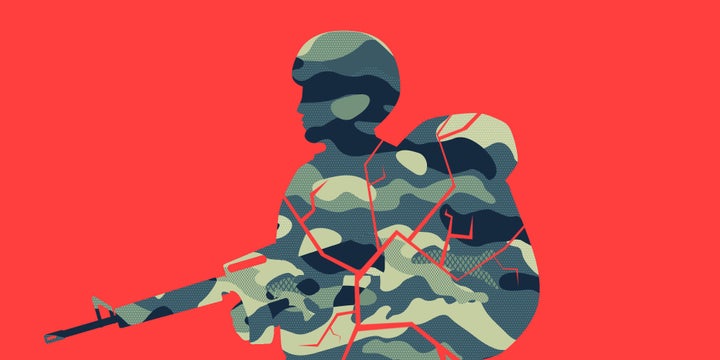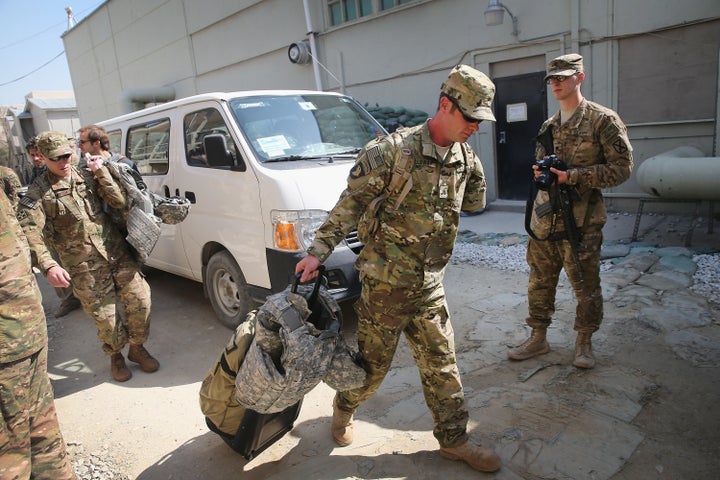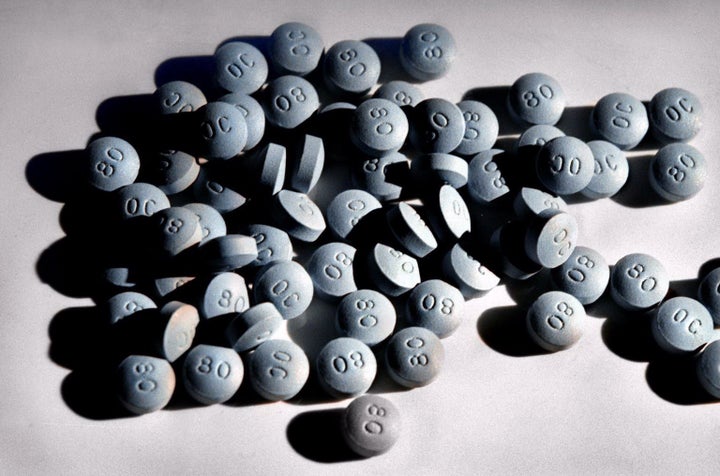https://www.huffingtonpost.com/entry/iraq-war-opioid-addiction-veterans_us_5aa17569e4b0d4f5b66eb332
By Erin Schumaker and Anna Almendrala

When Cpl. Darin Adams got back from serving in Iraq in 2009, he suffered from sharply painful back spasms ― a lingering symptom of an injury from falling off a ladder in the armory during his second deployment. After the fall, it didn’t occur to him to take off any time to rest, and he resumed carrying his 75-pound rucksack the next day.
By the time Adams, now 32, returned home, the pain was so bad that he sometimes couldn’t sleep at night or walk more than a few steps around the house. He took ibuprofen to ward off the pain, but his back spasms worsened until 2012, when the pain became so severe that he couldn’t get out of bed some mornings. Finally a doctor at the Veterans Administration put him on a low-dose opioid, which he began taking almost every day.
Adams worked as a manager at Walmart, which included lifting heavy boxes. He said if he hadn’t been taking opioids, it would have been impossible to do his job.

Adams is one of the thousands of Iraq War vets who came home with chronic pain.
Saddled with injuries that veterans from previous wars would never have survived, 60 percent of military members who fought in the Middle East were returning with chronic pain, a significantly higher rate than older veterans getting care from the VA. And their timing couldn’t have been worse: By 2005, two years into the Iraq War, 10 million Americans were taking prescription opioids for long-term pain relief.
But as prescription rates grew, so too did rates of overdose, accidental death and use of illicit opioids.
A dangerous pattern of pain, prescription and misuse was emerging among veterans. They were encountering serious harm overseas, receiving liberal amounts of prescription painkillers for their injuries and then bringing dangerous coping strategies back home with them.
A 2013 study on veterans who served after 9/11 illustrates this cycle well. “Joel” suffered serious injuries after a roadside bomb exploded near his tank. During his recovery program, the doctor prescribed hundreds of pills at a time, even though Joel had serious risk factors for addiction.
“They were giving me pain pills, I was getting Percocet, Vicodin. I was getting fucking OxyContin, Oxycodone. If I fucking wanted it, they would give it to me, no doubt about it,” Joel told the study researchers.
“I used to get like 460 at a time!” Joel continued. “[I told my doctor,] `Look I’m a heavy drinker,′ and he was like, ’Well, just take one before you start drinking, about an hour before you start, and then don’t take anymore after that until the morning.”
They were giving me pain pills, I was getting Percocet, Vicodin. … I used to get like 460 at a time!Joel, a study participant
Opioid prescription in the Veterans Administration health system skyrocketed 270 percent from 2001 to 2012. VA patients were twice as likely as other Americans to die of accidental opioid overdoses, according to a 2011 study, and another study found that 13 percent of all veterans taking opioids had an opioid-use disorder ― about 68,000 people.
By 2012, the VA had already started to look critically at their doctors who had been excessively prescribing opioids.
So by the time soldiers like Adams sought treatment, the VA was asking them to take mandatory classes at the VA pain clinic, and he spoke with a specialist about the dangers of opioid addiction. A year later, Adams appealed to the VA to approve surgery on his pinched nerve, which was causing his muscle spasms. But for the VA to sign off on the surgery, Adams had to do six months of physical therapy first.
In the end, physical therapy paid off. The more stretches and exercise Adams did, the less he needed his daily painkiller. By the end of the six-month waiting period, he had reduced his opioid use to one pill a month.
By medical standards, Adams’ decrease in the use of opioids is a success story. But his success was hard fought. For many other veterans who were prescribed opioids after returning from Iraq and Afghanistan, the daily pressure to live pain- and opioid-free is a continuing struggle.
“I guess I’m a unicorn,” Adams said, recounting that he just followed his doctor’s instructions closely. “It was successful for me, but it’s not successful, unfortunately, for everyone.”

By 2005, two years into the Iraq War, 10 million Americans were taking prescription opioids for long-term pain relief. From 1999 to 2010, prescription opioids sold to hospitals, pharmacies and doctors’ offices nearly quadrupled, according to the U.S. Centers for Disease Control and Prevention, while the amount of pain Americans reported stayed the same. So when vets started coming back complaining of chronic pain, their doctors ― largely employees of the Veterans Administration ― provided them with opioids just as they would any patient.
Opioid painkillers appeared to be effective at treating pain, were quick to prescribe and, unlike the morphine drips of yore, were simple to administer by pill. Best of all, according to pharmaceutical representatives, they weren’t addictive.
The medical community at large was lulled into a false sense of security about prescribing opioids until 2011, explained Louis Celli, the national director of veterans affairs and rehabilitation at the American Legion, a nonprofit veterans organization.
“This drug is extremely addictive,” Celli said. “There was less concern in the beginning, until this national epidemic took hold.”
Another constellation of factors made veterans more susceptible to opioid addiction. Men who enlist in the army are twice as likely as other Americans to have been sexually abused as children and to have grown up in an environment that included domestic violence and substance abuse. Moreover, 1 in 5 soldiers who volunteer to join the Army had disorders such as intermittent explosive disorder, post-traumatic stress disorder or attention deficit hyperactivity disorder before enlisting, which all increase one’s risk of addiction.
If the opioid epidemic were factored into the Iraq and Afghanistan body counts, that count would be staggeringly high. Many men and women who enlist are predisposed for substance abuse issues even before they’re issued uniforms. When soldiers from the Iraq and Afghanistan wars returned home, many had gruesome injuries that would have killed soldiers in past generations who didn’t have access to the same medical technologies. And now opioids were considered to be a safe and non-addictive first line treatment and were extensively prescribed to these returning soldiers.
Worst of all, insufficient research about treating veterans addicted to high-dose pills means that today’s best practices for treating veterans addicted to opioids are based on weak data. In this science-free environment, tapering off high-dosage opioids is akin to an act of faith.

In an effort to lower the risk of overdose and death among veterans taking opioids, the VA has taken incremental steps to lower new prescriptions, help veterans taper off existing medications, allow different centers within the VA to share data on opioid prescriptions for individual patients and be more transparent about how many opioids are being prescribed.
Consequently, change on opioids has come swiftly. From 2012 to 2017, opioid prescriptions are down 41 percent among patients, and the decrease is spread out across 99 percent of the VA’s facilities. Veterans who seek treatment after these shifts on opioids are benefiting from additional education on addiction risk, an emphasis on non-pharmaceutical or non-opioid therapies, and opioid prescriptions with lower doses.
In contrast, no other medical system in the U.S. releases comprehensive data on opioid prescriptions, and while almost all states now have databases that can track opioid prescriptions and flag patients for strange activity, most states don’t require doctors to check the database before issuing a prescription to a patient. VA doctors, on the other hand, are required to check the database before starting new patients on opioids.
Dr. Kenneth Goldberg, chief of staff and acting director of the Durham VA Healthcare System in North Carolina, is not Adams’ doctor, but he said that his story is an example of what the VA is doing right when it comes to opioid prescription.
“We want to get them on the lowest possible dose that we can,” Goldberg said. “One pill a month was his number. It’s not zero, but it’s definitely better than where it was.”
While the VA has continued to implement wide-ranging new policies that have resulted in steep cuts to their prescription rates, others who work closely with veterans say that these efforts have left some veterans scrambling for ways to manage their pain and may even be pushing them toward illicit drugs.
A 2017 study on Afghanistan and Iraq war veterans who had overdosed found that the transition to illicit, risky drugs like heroin was driven in part by the growing scarcity of prescription opioids, said Alex Bennett, a program director of the Opioid Overdose Prevention Program at National Development and Research Institutes who authored both this paper and the 2013 study that interviewed “Joel.” If veterans can’t stretch their limited opioid prescriptions until their next refill, some supplement that prescription with street drugs.
“In a place like New York City, it is roughly a dollar or two per milligram of Oxy, and a bundle of heroin can be purchased for $60, so people tend to do a cost-benefit analysis,” Bennett said. “Let’s say I have 60 Percs ― I can get rid of those, manage my pain and eat.”
For instance, “Barber,” a 54-year-old Army veteran featured in Bennett’s study, explained that when the prescribed Percocets weren’t enough to get him through to the next refill, he decided to sell the pills on the street and then use that money to buy heroin, which provided more relief for the two bulging vertebral discs in his spine.
“These are self-care and self-management strategies, in many ways,” Bennett said.
Because of this potential pipeline to illicit drugs, as well as other concerns, Dr. Stefan Kertesz, a frontline caregiver and long-term addiction researcher who teaches at the University of Alabama at Birmingham, isn’t convinced that everyone who takes high-dosage prescription opioids should be tapered off them as much as possible.
“If a patient is currently functioning OK from their point of view, [and then] if you change something that leaves them afraid they’ll function worse, that can be pretty violative,” Kertesz said.
Without scientific evidence, there’s no proof that weaning veterans off high doses of opioids protects their health. And without that scientific backing, some patients may be better off staying on opioids.
The existing data on tapering patients’ opioid doses is pretty bleak. A 2017 review of all tapering studies to date finds that among people who volunteer to have their opioid intake reduced, there is only low-quality evidence to suggest that their chronic pain levels and quality of life will improve once they decrease their opioid use. Keep in mind that these results are only for those who actually want to reduce their opioid consumption, said Kertesz, and doesn’t include participants like these veterans, who might feel like the VA is reducing their opioid intake against their will.
“Certainly we have no solid studies on involuntary mandatory dose reductions at all,” Kertesz said. “That should trouble you, because that means we’re flying blind.”
But scant high-quality evidence that tapering off opioids will make people safer doesn’t mean that we should accept the status quo, Goldberg explained.
“I don’t think any patient should take any medication that’s not really helping them,” Goldberg said.
This is especially because the status quo exposes veterans to opioid tolerance, overdose and death, said Dr. Chris Marx, who works alongside Goldberg as a psychiatrist at the Durham VA Medical Center.
“These are not medications without risk,” she said.
As for Adams, while he was skeptical about how physical therapy could help manage his back pain, he was pleasantly surprised by the results. By the end of the six-month waiting period, Adams’ back pain was so well-controlled that he decided to forgo the surgery altogether. Now he takes ibuprofen in addition to continuing his twice-a-day stretching routine. He still has an opioid prescription, but it’s for 25 pills a year — a far cry from his once-a-day routine — and he rarely uses them.
“The best advice I can give to a vet is if there is an alternative treatment, such as physical therapy, give it an honest shot,” he said. “There was a period of time that I didn’t think physical therapy was working, [and] I had to go a few times before I found a physical therapist that helped me see the light.”
Comment;
We’ve gone from “pain is the 5th vital sign” to opioid restriction. Now we look back at the errors of our ways and all of the patients who are suffering inadequately relieved pain
- COVID UPDATE: What is the truth? - 2022-11-08
- Pathologist Speaks Out About COVID Jab Effects - 2022-07-04
- A Massive Spike in Disability is Most Likely Due to a Wave of Vaccine Injuries - 2022-06-30

